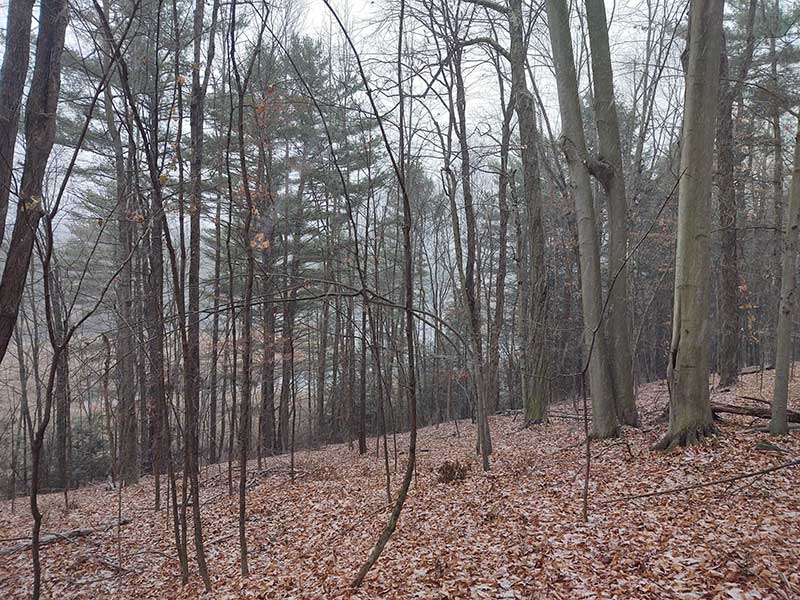soundcloud: Collaborative Composition - Tucker, Michael, Clare, And Tyler
Part 1 - Michael R.
One of the most memorable moments from my Mapping the Soundscapes experience was when Zoe and I went into the nature preserve and stumbled across five beavers chewing on a log. We captured their sounds and I was able to incorporate them into my group’s final recording. Collecting the beaver noises was an experience that I will never forget. Before this class, I had only entered the nature preserve once, and was not aware of all of the types of wildlife that existed. Being able to see beavers in the wild was a sight that I never thought I would get the chance to see, especially so close to where I live and go to class every day.
Additionally, I enjoyed the unique experience of making recordings during the rain. We traveled deep into the nature preserve, going up steep hills and recording the sounds of the water. This took many forms, including sounds of the rain hitting the ground and the rushing of the water down the mountain. It was interesting to see the different sounds that water can make within the nature preserve. The water sounds changed throughout the semester based on the seasons, as well as the variations in daily weather patterns. This was one of the reasons why we made the theme for our group project revolve around the changes in water over time.
Part 2 - Early Fall - Clare Daughtrey
In my section of the group composition, I chose to include sounds of chipmunks that I had recorded on November 2nd off the Anthill Trail by the abandoned blue car. It wasn’t my intention to record chipmunk sounds, but as I was sitting in front of the car, a chipmunk appeared from under the front bumper and started running back and forth through the interior of the car while chirping. Because I realized the shotgun microphone was dead when I reached the car, I recorded the chipmunk using the stereo mic built into the Tascam. Honestly, I think the stereo captured a better recording than the shotgun mic would have, because the chipmunk was moving back and forth quite rapidly and me moving the shotgun to follow it would have probably startled the chipmunk, and I also enjoy the surrounding ambience that the stereo mic captured. I chose to use the chipmunk sounds in my part of the group composition because I wanted to capture the feeling of the peacefulness of summer ending and the rising action of fall coming into play. I think combined with the rushing water and wind, the overlapping chipmunk chirps create a tense atmosphere that prepares the listener for winter.

I chose this image because it’s where I recorded the chipmunk sounds, and I think it shows a lot of early fall with the fallen leaves covering the ground, but also shows some remaining green on the trees in the background.
Part 3: Late Fall - Tyler Lippold
For my section I wanted to include some ambient noise from the rustling of leaves in the fall, as my dedicated section was near the end of the semester in late October to early November. The sound of the leaves is by far the most representative sound of this season to me, and so I felt like I should pull from those sounds to create the atmosphere I wanted. From my recordings, I pulled from shotgun microphone takes of the wind rustling through the leaves: I had several recordings where I pointed the microphone directly at the leaves in the wind, where I pointed at the leaves blowing on the ground, and where I set up the microphone in the lower levels of the trees themselves to get the leaf sound from a more ambient perspective than just pointing directly at them. Sticking with the central motif of water as a way to progress the piece, I also included running water sounds in this segment. I aimed to pick something that represents a steady flow, as our intent was to increase the speed of the water as the piece progressed, much like the increasing water flow throughout the semester, especially near the very end when the snow came and melted and ran off. I wanted, for textural purposes, to try to pick something with a stronger bass presence, in order to contrast against other higher pitched drip noises from other included water noises, which I thought would help to spatially position the listener in the running water itself.
Part 4 - Winter & Rushing Water - Tucker Carlson

The recording of snowfall is also one of my recordings, this time from Forest Loop Trail on November 15th. I wasn’t initially planning to record that day, but when it started snowing I knew I had to capture some of the sounds. The ground was covered with leaves and it made a very unique and surprisingly loud sound when snow fell on them. I got a few different recordings with different mics, but my favorite, and the one I used in this composition, was made with binaurals. The light sounds of snow falling all around was relaxing and created an immersive experience I can revisit just by listening to the clip.